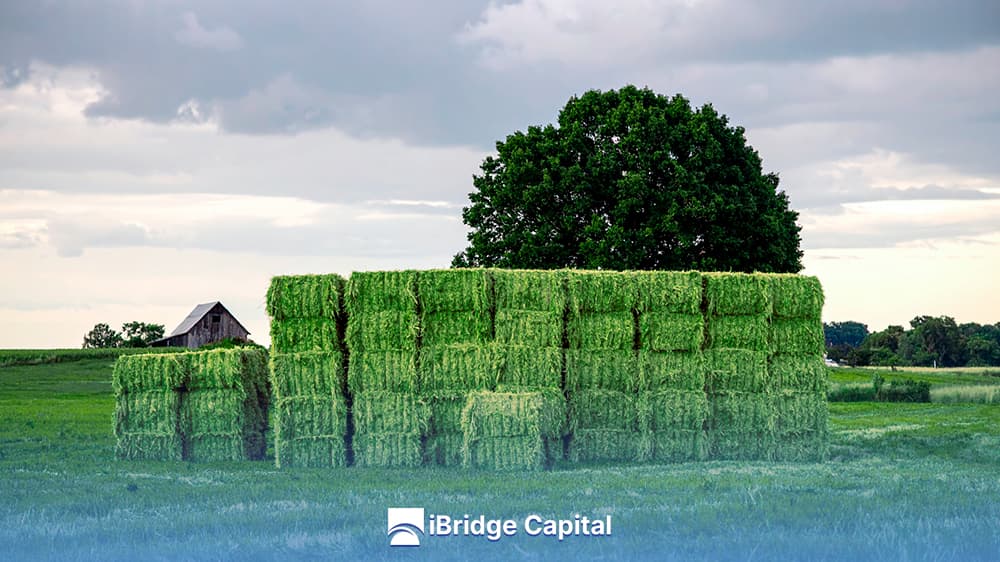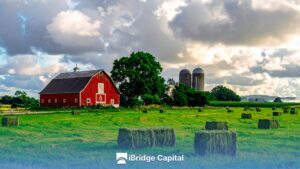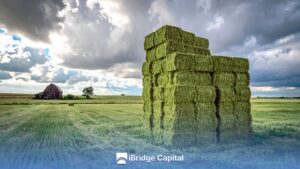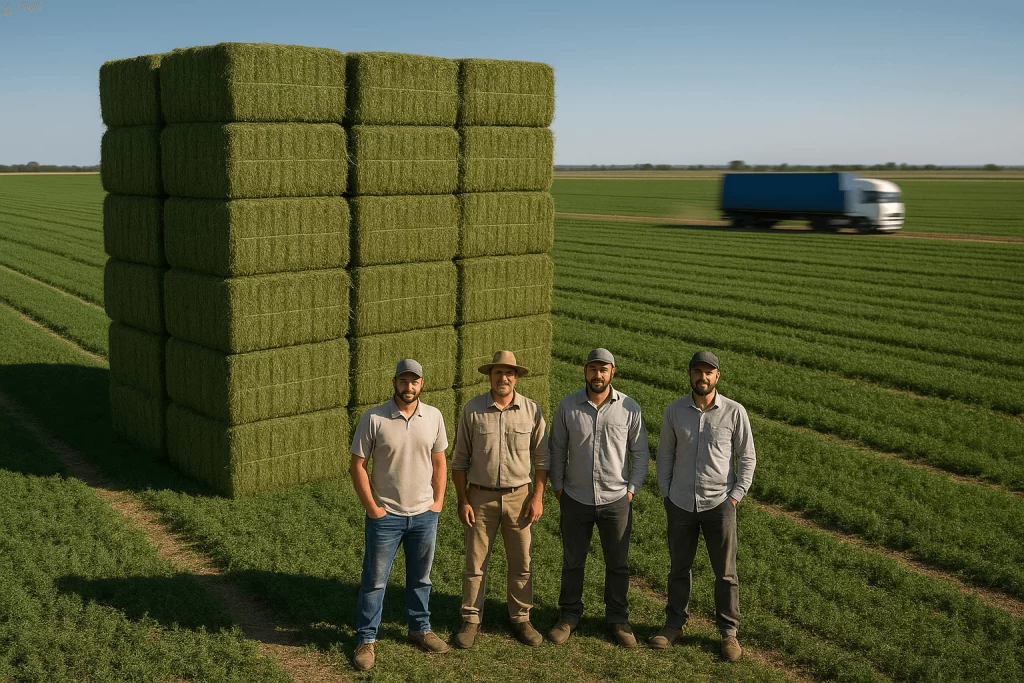In the Argentine countryside, there is an unwritten saying that states: “The one who works hard, succeeds.” However, in the forage sector, the harsh reality contradicts this belief. The trap of the Argentine forage producer is defined precisely by this paradox: the culture of working more hours does not translate into greater profitability, but often into less productivity per ton or per hectare.
This situation is not the result of a lack of effort, but of systemic inefficiency, lack of investment in precision technology, and the constant pressure of the climatic window in regions like Córdoba or the Humid Pampa. It is essential to analyze why extending the workday becomes a cost, instead of an advantage, and how to escape this cycle of fatigue and low margins.
The Dilution of Efficiency by Extending the Operational Day
The Argentine forage producer, in his eagerness to finish the harvest before a rain forecast or to fulfill a contract, extends his operational day to the limit. This effort, while admirable, dilutes the efficiency achieved during the central hours of the day.
The Point of Diminishing Returns in Harvesting Tasks
There is a point of diminishing returns where additional working hours not only stop adding value but begin to subtract. This is due to several factors:
- Personnel Fatigue: The forage producer’s fatigue increases calibration and handling errors, such as incorrect cutting height adjustment or rake speed, resulting in greater alfalfa leaf loss.
- Machine Speed: The forward speed decreases due to caution or fatigue, unnecessarily prolonging the harvest time.
Optimal operational efficiency is achieved within a limited time range, generally from 10 am to 6 pm, when moisture conditions are ideal. Working outside this range is diluting efficiency.
Night Work and Its Impact on Hay Quality
Night work on forages is common, especially for raking and baling, seeking to take advantage of high ambient moisture that prevents leaf shattering.
| Forage Task | Challenge of Night Work | Consequence on Productivity |
| Raking/Windrowing | Low visibility, increases the risk of incorporating soil. | Higher ash content, low hay quality. |
| Baling | Difficulty maintaining the ideal moisture percentage uniformly. | Risk of heating and mold in the center of the bale. |
Although night baling reduces leaf breakage, the risk of mechanical failures due to poor visibility and the decrease in operator concentration late at night are factors that reduce productivity per effective hour.
The Hidden Cost of Haste: Calibration and Maintenance Errors
The pressure to work more hours to compensate for low productivity leads to negligence in maintenance and calibration processes. This haste is the true hidden cost that affects long-term profitability.
Acceleration of the Machine Wear Rate
Equipment that works 16 hours a day without adequate rest and checking will inevitably suffer accelerated machine wear. Lack of timely lubrication or the omission of a preventive check increases the risk of catastrophic breakdowns.
- Higher Frequency of Breakdowns: Machines break down at the most inconvenient time (in the middle of harvest), generating costly downtime.
- Reactive Maintenance: The forage producer switches from planned preventive maintenance to reactive maintenance, which is much more expensive and urgent.
Critical Errors in Baler Calibration
Baler calibration is a precise task that is compromised by haste. A tired baler operator may fail to correctly adjust the compaction density or the conditioner pressure.
- Low Density: Soft bales that occupy more warehouse area required per ton.
- High Density: Increases alfalfa leaf shattering due to excess pressure.
These errors result in hay that does not meet the premium standard, directly affecting the profitability analysis of small bales and large ones.
The Investment Paradox: Less Technology, More Physical Effort
The forage producer’s trap is reinforced by a cycle of low technological investment, the producer who does not invest in efficient equipment is forced to compensate for the difference with more working hours and physical effort.
Resistance to Mechanization and High Labor Cost
Many small and medium forage producers resist investing in precision technology (high-end mower conditioners, megabales) due to the high initial costs.
| Harvest Format | Initial Investment (High) | Operational and Labor Cost (Low) |
| Megabale | Yes | No (mechanical) |
| Small Bale | No (Relatively Low) | Yes (manual) |
This decision, which seems cautious, translates into a high labor cost per ton that, in the long run, exceeds the financing cost of the most efficient technology. The use of small bales in intensive livestock farming becomes unfeasible without mechanized collection.
Old Technology: Lower Speed, Higher Consumption
Using previous generation machinery or machinery with advanced machine wear translates into a lower forward speed per hour and higher fuel consumption for small bale balers (or large ones) per ton. The producer ends up paying for obsolete technology with their time and a higher operating cost for each bale produced.
The Impact of Human Fatigue on Hay Quality
Low productivity due to the extension of the workday is directly reflected in the quality of the forage, negatively impacting the ability to sell to demanding markets.
The Effect of Fatigue on Leaf Loss
The forage producer’s fatigue leads to hasty decisions or not being rigorous enough in small bale vs large bale logistics. A tired operator is more prone to:
- Raking when the forage is too dry, maximizing leaf stripping.
- Baling outside the ideal moisture percentage due to wanting to finish quickly.
- Stacking disorderly, which increases the risk of deterioration in storage.
This human factor turns more working hours into less hay quality, frustrating any attempt to sell at a premium price.
Lower Efficiency in Loss and Quality Control
Loss control (due to breakage, leaching, or rot) is a continuous process that is neglected when working under stress. If the forage producer does not dedicate time to frequently monitor moisture content at baling, the chances of post-harvest losses due to fermentation or mold increase dramatically. The profitability analysis shows that it is better to harvest 20% less area with quality A than 100% of the area with quality C.
Escaping the Trap: Investment in Automation and Logistics
The only way to break the Argentine forage producer’s trap is to replace human energy with the operational efficiency of mechanization and optimized logistics.
Implementation of Mechanized Handling Systems
The cost savings with megabales in alfalfa is based on the simplification of handling. Investing in a hydraulic grab and a tractor is, in the long run, more economical than hiring personnel per harvest. This allows the producer to focus on agronomic management and transport logistics, instead of manual stacking of small bales.
Rigorous Planning and Climate Window Management
Adopting management software and detailed forecasts helps to make smarter cutting decisions. By having a higher forward speed per hour with modern equipment, the forage producer can concentrate the harvest in the optimal climatic window, ensuring quality and reducing the need to work more hours. The economic justification of giant bales lies in this capacity for reaction.
Redefining Productivity: From Quantity of Hours to Added Value
Productivity in forage should be measured in added value (RFQ, Crude Protein, Digestibility) per ton, not in the number of hours the personnel were in the field.
The Role of the Forage Producer as a Specialized Technician
The future of the Argentine forage producer shifts from being an intensive manual laborer to a specialized technician in agro-logistics. Their more working hours should be dedicated to:
- Planning: Models of operating cost and profitability.
- Quality: Precision calibration and monitoring of stacked quality.
- Marketing: Definition of the small bale niche market or the placement of the megabale.
The focus must be on how to optimize small bale production (if that is the niche) or on the efficiency of small bale production in Argentina through total mechanization.
Productivity Comparison Per Hectare (Simulation)
| Scenario | Total Working Hours (Personnel) | Production Rate (Ton/Hr) | Labor Cost Per Ton (Relative) |
| Forage Producer’s Trap (Manual Small Bale) | $200$ | $0.5$ | High |
| Technological Escape (Mechanized Megabale) | $40$ | $2.5$ | Low |
Long-Term Consequences: Business Longevity and Sustainability
The forage producer’s trap is unsustainable in the long term, affecting the longevity of the business and the quality of life of the producer.
Rural Exodus and the Scarcity of Replacement
The physical demand of working more hours on manual tasks is a key factor in the rural exodus. As workers leave the field, the labor scarcity worsens, forcing the producer to work more hours personally, closing the vicious circle.
The Economic Sustainability of Forage in Argentina
The sustainability of the forage business is linked to logistical efficiency. Producers who remain trapped in the mentality of more working hours, less productivity will be unable to compete with the operating costs of megabale producers and will tend toward economic marginalization. Investment in automation of small bale collection technology is a necessity, not a luxury.
Conclusion:
Effort is essential, but intelligence is what defines profitability in the modern field. The Argentine forage producer must stop seeing the tractor as a competitor and embrace it as the partner that frees up their time and protects their margin.
Their energy should not be spent on manually moving bales, but on planning, calibrating, and seeking logistical solutions. Breaking the trap is not about working less, it is about working strategically, making every hour dedicated to forage translate into higher quality hay and a more sustainable future for your business.





